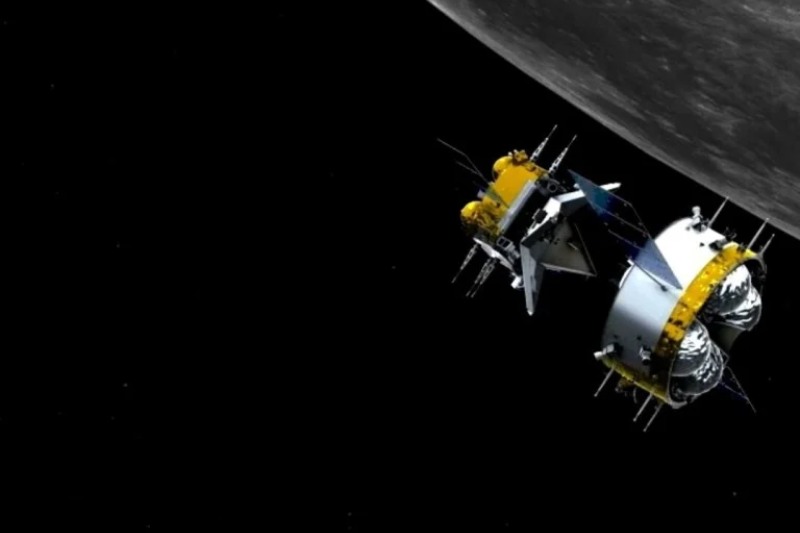In an additional step toward gathering lunar samples, China’s Chang’e-6 lunar far side sample return spacecraft reached orbit around the moon late on Tuesday.
The China National Space Administration (CNSA) said that the Chang’e-6 orbiter successfully performed a braking burn at 10:21 p.m. Eastern on May 7 (0221 UTC on May 8), slowing the probe down to enable it to be grabbed by the moon’s gravity.
The mission left Earth on May 3 and traveled to the moon over the course of around 112 hours. With the potential for significant scientific benefits, this is the first attempt to gather samples from the moon’s far side.
For the braking burn, the orbiter’s 3,000N engine was employed. It is believed that the Chang’e-6 spacecraft is in an elliptical lunar orbit with a 200-kilometer periapsis. Next, Chang’e-6 will launch Icube-Q, a 7-kilogram cubesat, into lunar orbit. After then, the primary spacecraft will progressively turn its orbit around in order to make a landing.
Ahead of the attempted landing in Apollo Crater, the mission lander will detach from the spacecraft. Although not formally confirmed, the landing is anticipated to occur in early June because the lighting over Apollo Crater is currently not ideal for landing and surface operations.
The target landing spot is believed to include material that has been dug from the moon’s mantle and is located within the enormous, ancient South Pole-Aitken Basin (SPA). Such samples could provide fresh information about the moon, including its history and the differences between its near and far hemispheres, through analysis.
For Chang’e-6, what Comes Next?
According to information released by the Deep Space Exploration Laboratory (DSEL) under CNSA, the Chang’e-6 mission is anticipated to take 53 days from launch to landing.
On May 28, there will be a sunrise over Apollo Crater. Accordingly, Chang’e-6 is probably going to try landing in early June, once the sun has risen high enough in the sky to cover the landing site. The timing of the effort will rely on the orbit of the spacecraft and limitations on surface lighting conditions for power generation.
The sampling process will probably be completed 48 hours after landing, similar to Chang’e-5, for which Chang’e-6 is a repurposed backup. An ascending vehicle will transport samples into lunar orbit and then monitor the Chang’e-6 orbiter.
According to the last mission, the two are expected to meet and dock approximately two days following launch, with the ascender being abandoned a few days after that. At a certain moment, the orbiter would then get ready to exit lunar orbit. Then, on or around June 25, it would launch a reentry capsule shortly before making its way down to Earth.
Earth never gets to see the moon’s far side. This results from the moon’s rotation being slowed down by our planet and being tidally locked. Thus, the Queqiao-2 satellite supports the mission. In order to relay communications between Chang’e-6 on the far side and Earthly base stations, Queqiao-2 is functioning in a specific orbit.
Additional Goals
In addition to returning samples, Chang’e-6 also contains payloads for future scientific research. In addition to the aforementioned cubesat, the mission includes international payloads from France, Sweden, Italy, and Pakistan.
The French-made Detection of Outgassing RadoN (DORN) instrument is also carried by the lander. Using this, radon released from the lunar crust will be detected. Sweden provided the “Negative Ions at the Lunar Surface” (NILS) payload with assistance from ESA. The lander also has an Italian passive laser retro-reflector.
Photographs of Chang’e-6 taken after launch also show that a little rover is aboard.
Chang’e-6 is a component of China’s larger lunar objectives. The nation will conduct two further trips to the lunar south pole. Chang’e-7 in 2026 and Chang’e-8 in the vicinity of 2028 are these. By 2030, the nation hopes to send out its first crewed lunar expedition.
The goal of both mission sets is to create a long-term lunar base. The International Lunar Research Station (ILRS) program is this project, which is scheduled for completion in the 2030s. Numerous nations and institutions have committed to the project.
